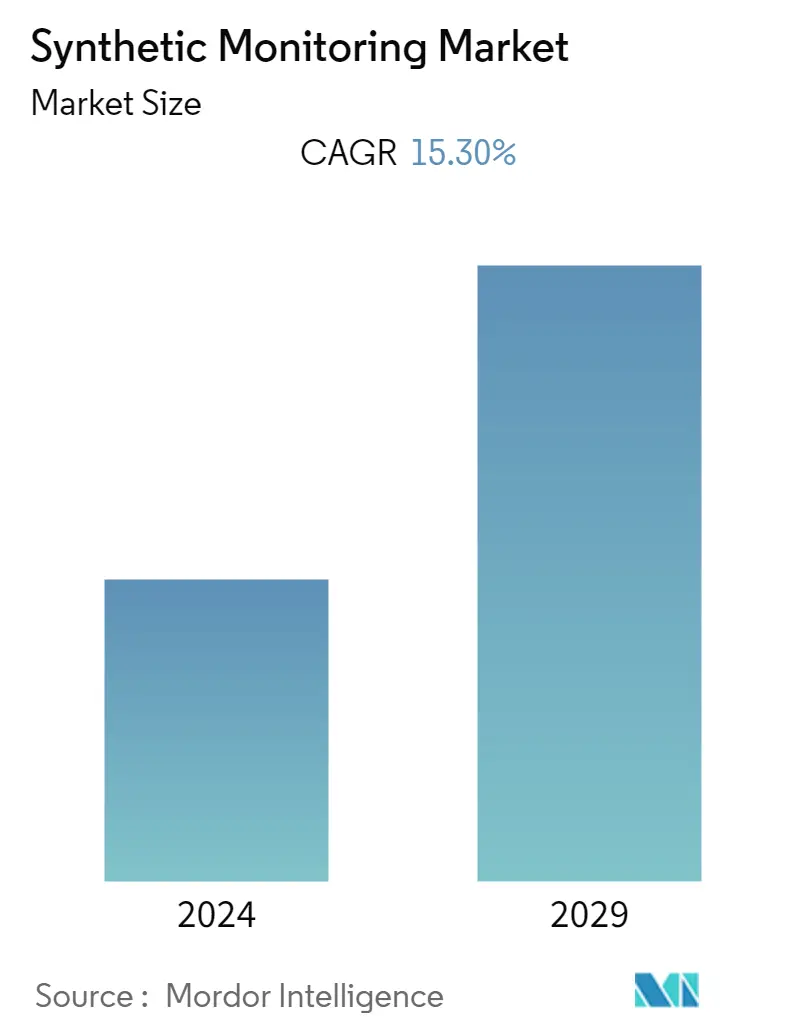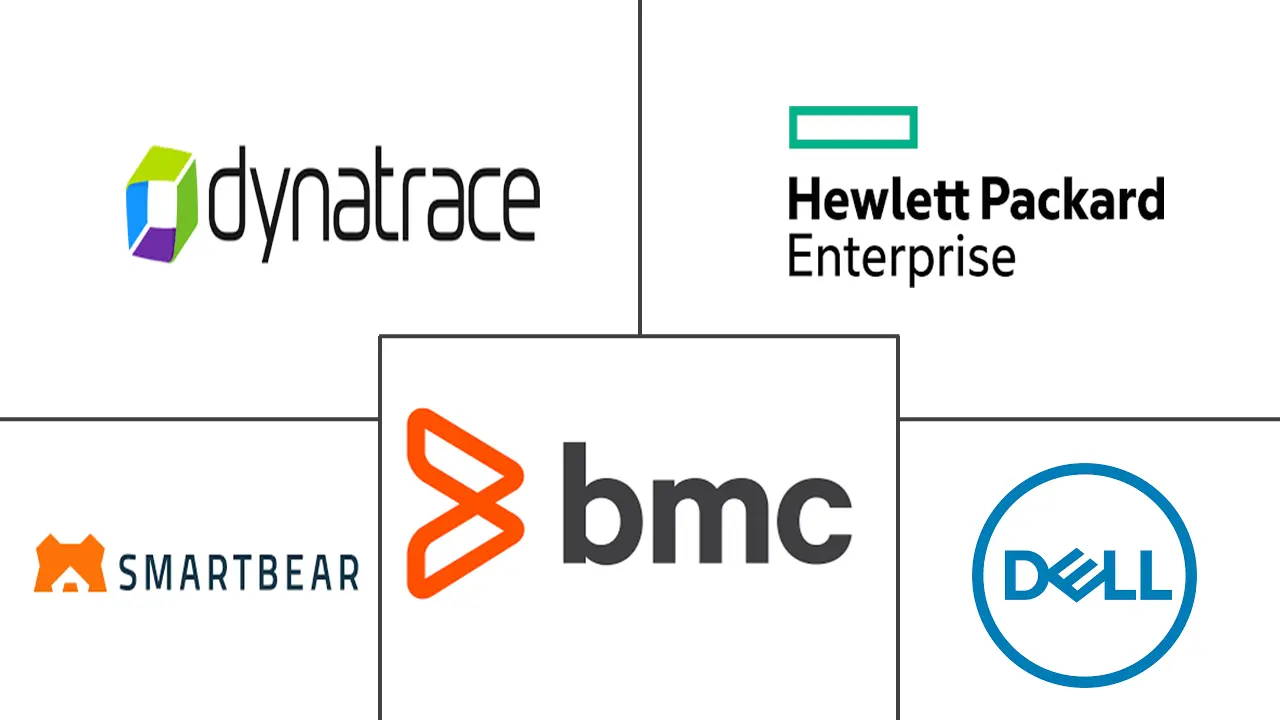Market Size of Synthetic Monitoring Industry

| Study Period | 2019 - 2029 |
| Base Year For Estimation | 2023 |
| Forecast Data Period | 2024 - 2029 |
| CAGR | 15.30 % |
| Fastest Growing Market | Asia Pacific |
| Largest Market | North America |
| Market Concentration | Low |
Major Players
*Disclaimer: Major Players sorted in no particular order |
Synthetic Monitoring Market Analysis
The synthetic monitoring market will register a CAGR of 15.3% during the forecast period.
- Synthetic monitoring involves web browser script recordings or web transactions, wherein behavioral scripts are created to simulate a user's path on a site. It helps monitor ongoing IT service performance. Synthetic monitoring, by tracking affected user transactions, ensures that the problems and issues can be quickly identified and resolved, ideally before users complain or notice.
- Businesses worldwide have focused on enhancing the overall user experience to retain their customer base amidst high competition. This trend has been playing a significant role in driving demand for synthetic monitoring solutions.
- Active monitoring is essential in the complex infrastructure many IT teams manage, where multiple networks, providers, and applications can consume IT time and resources. Therefore, synthetic monitoring helps troubleshoot these cases, as it continuously shows IT teams what users see.
- Additionally, to meet the growing need for sophisticated user experiences, businesses are turning to synthetic monitoring for third-party components like web analytics, social networking, search engine optimization, and others.
- Moreover, the increasing use of smartphone application-based services for various purposes is anticipated to increase demand for mobile application monitoring to analyze user behavior and improve user experience, which is anticipated to benefit the market over the course of the forecast period.
- Due to high implementation costs, false positives and inaccurate alarms, a lack of real-time monitoring, difficulties with post-implementation administration, and emulator-based monitoring, managing synthetic monitoring solutions can be problematic.
- The demand for synthetic monitoring among businesses has increased during COVID-19. Due to its ability to keep up with daily operations and essential business functions, remote working is growing in popularity among large and small organizations. Lastly, to secure data and ensure a superior end-user experience, these advances have fueled a steady rise in demand for high-performance and secure deployment types over the past few months.
Synthetic Monitoring Industry Segmentation
Synthetic monitoring is a technique for controlling how people navigate around your applications by imitating user activity. With the help of this targeted monitoring, you may learn about the uptime, performance, and most frequent application paths for your crucial business transactions.
The synthetic monitoring market is segmented by type (API monitoring, website monitoring, and mobile applications monitoring), end-user vertical (BFSI, it and telecommunication, retail, government, manufacturing and automotive, and military and defense), and geography (North America, Europe, Asia Pacific, Latin America, and Middle East & Africa).
The market sizes and forecasts are provided in terms of value (USD million) for all the above segments.
| By Type | |
| API Monitoring | |
| Website Monitoring | |
| Mobile Application Monitoring |
| By End-User Vertical | |
| BFSI | |
| IT and Telecommunication | |
| Retail | |
| Government | |
| Manufacturing and Automotive | |
| Military and Defense | |
| Other End-user Verticals |
| By Geography | |
| North America | |
| Europe | |
| Asia Pacific | |
| Latin America | |
| Middle East and Africa |
Synthetic Monitoring Market Size Summary
The synthetic monitoring market is experiencing significant growth, driven by the increasing need for businesses to enhance user experience and maintain competitive advantage. This technology involves simulating user interactions on websites to monitor IT service performance proactively. By identifying and resolving issues before they impact users, synthetic monitoring plays a crucial role in managing complex IT infrastructures that include multiple networks and applications. The rise in smartphone application usage further fuels demand for mobile application monitoring, as businesses seek to analyze and improve user behavior and experience. Despite challenges such as high implementation costs and the potential for false positives, the market is expanding as organizations adopt remote working and require robust solutions to ensure seamless operations and secure deployments.
North America is poised to dominate the synthetic monitoring market, driven by the adoption of advanced technologies like DevOps and cloud computing. The region's focus on enhancing application management services and improving user experience through real-time analysis and advanced analytics is propelling market growth. Companies are increasingly investing in modern synthetic monitoring systems to optimize application performance and reduce response times. The market is characterized by a lack of cohesion, with major players employing various strategies such as product launches, partnerships, and acquisitions to expand their presence. Notable companies like Dynatrace LLC and SmartBear Software are leading the charge, offering innovative solutions that integrate observability, application security, and data management to meet the evolving needs of businesses.
Synthetic Monitoring Market Size - Table of Contents
-
1. MARKET INSIGHTS
-
1.1 Market Overview
-
1.2 Industry Attractiveness - Porter's Five Forces Analysis
-
1.2.1 Bargaining Power of Suppliers
-
1.2.2 Bargaining Power of Consumers
-
1.2.3 Threat of New Entrants
-
1.2.4 Intensity of Competitive Rivalry
-
1.2.5 Threat of Substitutes
-
-
1.3 Technology Snapshot
-
-
2. MARKET SEGMENTATION
-
2.1 By Type
-
2.1.1 API Monitoring
-
2.1.2 Website Monitoring
-
2.1.3 Mobile Application Monitoring
-
-
2.2 By End-User Vertical
-
2.2.1 BFSI
-
2.2.2 IT and Telecommunication
-
2.2.3 Retail
-
2.2.4 Government
-
2.2.5 Manufacturing and Automotive
-
2.2.6 Military and Defense
-
2.2.7 Other End-user Verticals
-
-
2.3 By Geography
-
2.3.1 North America
-
2.3.2 Europe
-
2.3.3 Asia Pacific
-
2.3.4 Latin America
-
2.3.5 Middle East and Africa
-
-
Synthetic Monitoring Market Size FAQs
What is the current Synthetic Monitoring Market size?
The Synthetic Monitoring Market is projected to register a CAGR of 15.30% during the forecast period (2025-2030)
Who are the key players in Synthetic Monitoring Market?
Dynatrace LLC, Smart Bear Software Inc., HP Enterprise Company, Dell Technologies Inc. and BMC Software Inc. are the major companies operating in the Synthetic Monitoring Market.

